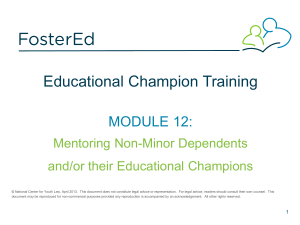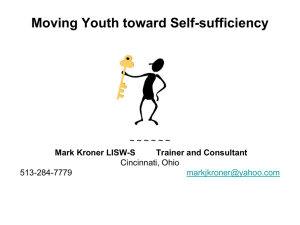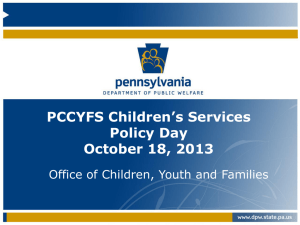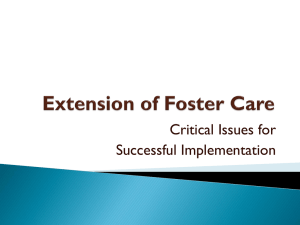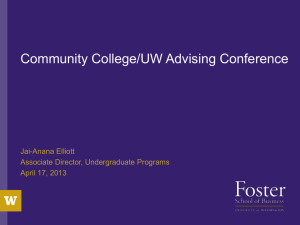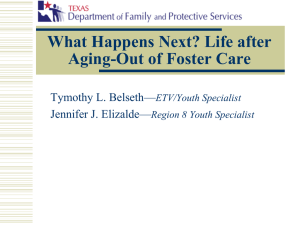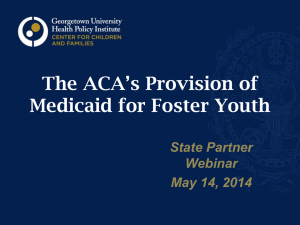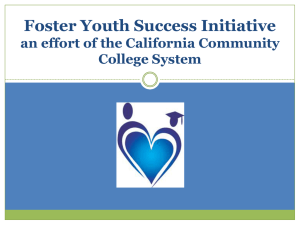Foster Care Education: Texas Trio Project
advertisement
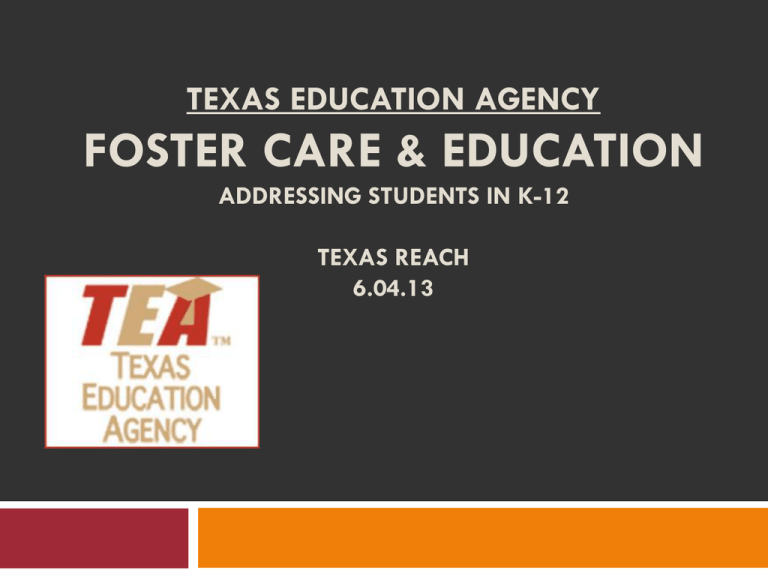
TEXAS EDUCATION AGENCY FOSTER CARE & EDUCATION ADDRESSING STUDENTS IN K-12 TEXAS REACH 6.04.13 Workshop Goals Texas Education Agency - Introduction Education Impacts of Foster Care Data & Information Federal & State Law School District Foster Care Liaison(s) Linking with District Liaisons Resources Texas Trio Project 17-month federal demonstration grant, Child Welfare - Education System Collaborations to Increase Educational Stability (CWED), from U.S Dept of Health and Human Services, Administration for Children & Families 1 of 10 states chosen to highlight collaboration and cross-systems work addressing the education outcomes of children and youth in foster care. TEA hired Foster Care & Education Policy Coordinator to coordinate grant activities and develop agency capacity Build model collaboration - Facilitate improved coordination, communication, and practice TEA; DFPS; Supreme Court Children’s Commission Implement local pilot project Partnered with HISD and local DFPS to identify: enrollment & withdrawal, cross-system training, additional barriers, and needs, etc. Worked in 3 pilot schools. Supreme Court Children’s Commission: Education Committee May 20, 2010 Supreme Court of Texas signed order establishing Education Committee of Permanent Judicial Commission for Children, Youth and Families. Focused on improving educational outcomes of foster children and youth. Coordinated effort of numerous agencies and systems involved with child protection and education including -100 stakeholders. Charged to look at challenges, identify judicial practices and cross-disciplinary training needs, improve collaboration, and make recommendations regarding education. Seek to improve collaboration, communication & practice through partnerships with DFPS, TEA, and stakeholders in education and child protection community. Over 100 recommendations and strategies identified related to: School readiness, School Stability & Transitions, School Experience, Supports & Advocacy, Post Secondary Education. http://texaschildrenscommission.gov/PDF/TheTe xasBlueprint.pdf TO THE ADMINISTRATOR ADDRESSED (TAA) Letters regarding students in foster care: Subject: Foster Care Awareness, May 17, 2013 available online: http://www.tea.state.tx.us/index4.aspx?id=25769804968 Subject: Child Abuse and Neglect Reporting Requirements, March 6, 2013 available online: http://www.tea.state.tx.us/index4.aspx?id=25769803997 Subject: Importance of Maintaining the Education Stability for Children and Youth in the Foster Care System, August 22, 2012 available online: http://www.tea.state.tx.us/index4.aspx?id=2147508587 Subject: Attendance, Admission, Enrollment, Records and Tuition, August 2, 2012 available online: http://www.tea.state.tx.us/index4.aspx?id=2147508100 TEA Listserv sign-up: http://miller.tea.state.tx.us/list/ High Mobility - Foster Care impacts education: Significant problems with transferring information and documentation between educational and child welfare systems. Records may be lost or misplaced, causing youth to lose credits and/or repeat classes. Records may not transfer in a complete and timely manner. Youth may not be appropriately withdrawn from school, resulting in lowering of youth’s grades. Youth may sit out of school for days/weeks at a time, or are placed in inappropriate classes upon transferring to a new school. By 6th grade, students who had changed schools 4 or more times lost about 1 year of educational growth (Courtney et al, 2004). Casey Family Services, ‘Education Stability for Children & Youth in Foster Care’ Additional Impacts on Education Stability (multiple school & home placements) Separation/Loss family Trauma impacts learning Special Education Missed school days for appointments Stigmatization Socialization Lower scores on standardized tests Loss of important educational, social, cultural connections. For every school move - students in foster care lose 4-6 months of emotional growth & academic preparation. (Advocates for Children of New York, Inc. 2000) Texas: 36,441 Texas children encounter the child welfare system 16,000 school age children are in foster care 23.1% (highest percentage) of children in care are 14-17. 1,410 young people exited from care in 2011. On average each of these youth moved 8 times. Casey Family Programs, Austin, TX Webinar HB 452, Feb 2012, DFPS 2011, Data Book. Education Outcomes - Foster Care in Texas Fact: 40.7% of school leavers (reason for leaving school) for students in foster care are coded as graduated, as compared to 70.7% of school leavers statewide for students not in foster care, in grades 7-12. This is not a graduation rate. (PEIMS 2010-11) Fact: 28.7% of school leavers (reason for leaving school) for students in foster care are coded as dropped out, as compared to 8.4% of school leavers statewide for students not in foster care, in grades 7-12. This is not a dropout rate. (PEIMS 2010-11) Fact: Students in foster care are almost three times more likely (24.5%) to receive special education services compared to students in the general population (8.8%). (PEIMS 2011-12) PEIMS: 2011 Leaver Status of Students Who Left Texas Public Schools, Grades 7-12 2010-11 10 Counts of Foster Children % of Foster Children Statewide Counts Statewide % Graduated 631 40.7 290,581 70.7 Dropped Out 445 28.7 34,389 8.4 149 9.6 36,356 8.8 86 5.5 20,876 5.1 157 10.1 702 0.2 88 5.3 28,236 6.9 Left for non-graduate, non-dropout reasons: School outside Texas Homeschooling Removed by Child Protective Services All other non-graduate, non-dropout reasons Note: The percentages on the first two rows are not graduation or dropout rates. These numbers represent the number of students who graduated or dropped out during the year divided by the total number of students who left during that school year. Foster Children Compared to the State Population Dropouts by Grade 2010-11 11 40 35 30 25 20 Foster Children % Statewide % 15 10 5 0 Grade 7 Grade 8 Grade 9 Grade 10 Grade 11 Grade 12 Foster Children Compared to the State Population Graduates by Graduation Program Type 2010-11 12 80 70 60 50 Foster Children % Statewide % 40 30 20 10 0 Minimum Recommended Distinguished Counts and Percentages of Foster Children by Gender and Ethnicity: 2011-12 Counts of Foster Children 13 % of Foster Children Statewide Counts Statewide % Female 11,554 48.1 2,432,216 48.7 Male 12,465 51.9 2,566,363 51.3 American Indian/ Alaskan Native Asian Black or African American Hispanic/Latino Native Hawaiian/ Other Pacific Islander White Two or more races 105 0.4 22,383 0.4 88 0.4 177,185 3.5 5,765 24.0 640,171 12.8 42.4 2,541,223 50.8 10,190 28 7,264 579 0.1 6,257 0.1 30.2 1,527,203 30.6 2.4 84,157 1.7 Counts and Percentages of Foster Children by Program: 2011-12 14 Category At Risk Career and Technology Economically Disadvantaged Gifted and Talented Immigrant Limited English Proficient (LEP) PK Military Special Education Counts of Foster Children % of Foster Children Statewide Counts Statewide % 16,307 67.9 2,267,995 45.4 2,540 10.6 1,072,893 21.5 21,669 90.2 3,013,442 60.3 225 0.9 381,744 7.6 20 0.1 71,754 1.4 1,480 6.2 838,418 16.8 18 0.1 6,033 0.1 5,884 24.5 440,744 8.8 Counts and Percentages of Special Education Foster Children by Primary Disability: 2011-12 15 Counts of Special Education Foster Children % of Special Education Foster Children Statewide Counts of Special Education Children Statewide % of Special Education Children Emotional Disturbance 2,055 34.9 26,303 6.0 Learning Disability 1,152 19.6 172,560 39.2 Intellectual Disability 806 13.7 35,992 8.2 Other health impairment 748 12.7 56,426 12.8 Speech Impairment 598 10.2 89,646 20.3 Federal Law Provisions for Students in Foster Care Fostering Connections to Success and Increasing Adoptions Act, 2008 Emphasizes the importance of school stability, maintaining the students school placement, importance of coordination between child welfare and education agencies. Assurance that the placement take into account appropriateness of current education setting & proximity to the school in which the child is enrolled at the time of placement. If not in the best interest – state & local education agency provide immediate and appropriate enrollment in new school with ALL of the education records of the child provided to new school. Amendment to Family Educational Rights and Privacy Act (FERPA) Uninterrupted Scholars Act: Permits educational agencies and institutions to disclose education records of students in foster care to State and county social service agencies or child welfare agencies. The statute also amended the requirement that educational agencies and institutions notify parents before complying with judicial orders and subpoenas in certain situations. http://www2.ed.gov/policy/gen/guid/fpco/hottopics/inde x.html State Law Texas Education Code Provisions for Students in Foster Care Texas Education Code Recognizes students in foster care: Immediate school enrollment - TEC 25.002 Timely Records transfer - TEC 25.002(a-1) Students grades 9-12 are entitled to finish high school where they were enrolled at the time of placement - TEC 25.001 (g) Free eligibility for PRE-K - TEC 29.153 Accelerated Instruction (At-risk indicators and Compensatory Education) - TEC 29.081 (Code #11) School District Foster Care Liaisons - TEC 33.904 Free College Tuition & Fee Waiver – TEC 54.366 TEA to assist the transition from one school to another of students in foster care - TEC 25.007 School District Foster Care Liaison: “Each School District shall appoint at least one employee to act as a liaison officer to facilitate the enrollment in or transfer to a public school of a child in the district who in the conservatorship of the state. (TEC 33.904)” Tuition & Fee Waiver (TEC 54.366) Sec. 54.366. (a) A student is exempt from the payment of tuition and fees authorized in this chapter, including tuition and fees charged by an institution of higher education for a dual credit course or other course for which a high school student may earn joint high school and college credit. Enrolls…..no later than the student's 25th birthday. Transition Assistance for Students in Foster Care TEC 25.007: Encouraging school districts and open-enrollment charter schools to provide services for a student in foster care in transition when applying for admission to post-secondary study and when seeking sources of funding for postsecondary study; Foster Care: Who Are the Players? Family Court/Judge Attorney/Atto ney Ad Litem Caregiver Student DFPS: Social Worker, Education Specialist, PAL & others Therapy/ Medical Guardian Ad Litem; CASA Community School Transition to Adulthood Family Student Community DFPS: PAL, After Care LINKING WITH DISTRICT LIAISONS TO SUPPORT STUDENTS IN FOSTER CARE: Bridging the Gap: Introduce yourself to district liaisons. Host a collaborative forum with district liaisons and other groups who support the education of students in foster care. (ACC Luncheon) Create opportunities and include students where the tuition and fee waiver may be activated: summer bridge programs, introductory courses, mini-terms, and other opportunities. Communicate with liaisons about campus events and incorporate students. Host a celebration for graduating high school students. Include others involved in student’s life: judge, CASA, caseworkers, caregiver, etc. TEA and Liaisons: Building Capacity Identifying district liaisons and developing a contact list. TEA Website: Foster Care & Student Success http://www.tea.state.tx.us/FosterCareStudentSuccess/ Webinar Trainings (Foster Liaison 101, CPS/Court overview) Foster Care Education Listserv http://miller.tea.state.tx.us/list/ sign-up to received updates. Resource Guide – Coming Summer 2013! Email: Fostercareliaison@tea.state.tx.us Foster Care Education & Policy Coordinator, fostercareliaison@tea.state.tx.us; kelly.kravitz@tea.state.tx.us; 512-463-9235 Coming Soon… Resource Guide - Summer 2013! Resource Guide Chapters: Education & Students in Foster Care 2) Increasing Cross-System Awareness 3) Building Cross-System Partnerships 4) Understanding Foster Care 5) District Foster Care Liaisons 6) Identifying Students & Maintaining Confidentiality 7) Enrollment 101 8) School Stability & Promoting Effective Transfers 9) Education Decision Making & FERPA 10) Additional School Provisions 11) The School Experience – Providing Student Support 12) Special Education 13) Planning For Transitioning & Post Secondary Education 1) Education Service Center Regions 32 Welcome to Texas Supporting Success! This new free online program has been created exclusively for young people in foster care. It has articles, quizzes, information, tips and tools to help you manage your life , prepare for independent living, and plan for a happy future. Additional Resources: www.ownyourownfuture.com www.texascollegeandcareer.org www.texassupportingsuccess.org www.texasgearup.com/byot/category/ Texas Youth Connection: http://www.dfps.state.tx.us/txyouth/default.asp “A Youth Guide to School and Success” – Treehouse for Kids, Seattle, WA. Thank you! Kelly Kravitz, TEA Kelly.kravitz@tea.state.tx.us (512) 463-9235
